Last updated: March 22, 2019
Article
Bat Acoustic Monitoring at Jewel Cave National Monument

NPS
Overview
Jewel Cave National Monument is a 1,274-acre park in the Black Hills of western South Dakota established to protect the third longest cave in the world. While the main visitor area of the cave does not have bats, an entrance enlarged in the early 1900s is now used as a bat hibernaculum (winter home for bats). Surface water is rare in the park where the majority of habitat is open ponderosa pine forest with grassland meadows, though there is a sewage pond that potentially provides a source of drinking water for bats.
The Northern Great Plains Inventory & Monitoring Network monitors to detect long-trends and to get early warning of undesirable changes in bat populations at the park. A fungal disease called white-nose syndrome is spreading quickly, threatening bat populations in North America. First documented in a New York cave in 2006, this disease is associated with more than seven million bat deaths. It spreads primarily from bat to bat and humans might be spreading the disease by carrying nearly invisible fungal spores on their shoes and clothing from one cave to another. Bat monitoring helps us understand changes occurring with the spread of this devastating disease.
Acoustic Monitoring
Four acoustic recording stations were established in 2014 and 2015 at Jewel Cave National Monument. Acoustic recorders detect the unique ultrasonic calls bats use for echolocation. There were 30,450 bat call recordings from stations across all survey nights from 2014 to 2017. The data were analyzed through specialized software programs that make preliminary identifications of the bat species based on individual call characteristics, such as frequency and shape. Some bat species make calls that are similar to other species, which is why researchers with special expertise review the calls and make the final species determinations.

Pete Pattavina/USFWS (https://creativecommons.org/licenses/by/2.0/legalcode,cropped)
Bats at the Park (2014- 2017)
| Common Name | Scientific Name | 2014–2017 Status |
|---|---|---|
| Townsend's big-eared bat | Corynorhinus townsendii | Present |
| Big brown bat | Eptesicus fuscus | Present |
| Eastern red bat | Lasiurus borealis | Present |
| Hoary bat | Lasiurus cinereus | Present |
| Silver-haired bat | Lasionycteris noctivagans | Present |
| Western small-footed myotis | Myotis ciliolabrum | Present |
| Little brown bat | Myotis lucifugus | Present |
| Northern long-eared bat | Myotis septentrionalis | Present |
| Fringed myotis | Myotis thysanodes | Present |
| Long-legged myotis | Myotis volans | Present |
| Tri-colored bat | Perimyotis subflavus | Present |
- Eastern red bat, and tri-colored bats were new detections for the park. These two species are on the western edge of their range at Jewel Cave National Monument. Hear what a Eastern red bat sounds like!
- Big brown, hoary, and silver-haired bats were recorded most often on the park. The historically common long-legged myotis made up only a small proportion of the acoustic recordings.
- The threatened northern long-eared bat is present on the park, but was detected in very low numbers. It was also captured in mist nets in 2017. This species is heavily impacted by white-nose syndrome and it has suffered large population declines throughout its range in recent years.
- The sewage pond likely plays a critical role in bat reproduction, lactating females make regular use of surface water and the acoustic station by the pond had the highest rate of detections.
- Little brown bats, known to forage over water, were more common at the sewage pond, whereas the western small-footed myotis, an arid land species, was more frequent in the dry Lithograph Canyon site.
- In addition to our work, park staff are monitoring bats using acoustic recorders, cave surveys, and telemetry.

NPS/Timpanogos Cave National Monument
White-nose Syndrome
White-nose syndrome has not yet been detected at the park, it was detected on a bat in Black Hills National Forest, just south of the boundary of Jewel Cave National Monument. See a map of white-nose syndrome in national parks and learn more about how you can help prevent the spread of this fungus. Continued monitoring, and park staff and visitor observations, will help us protect the bat communities that live and forage in the park.
For More Information
Dan Licht, Midwest Region Wildlife Biologist
Protocol Contact: Northern Great Plains Network